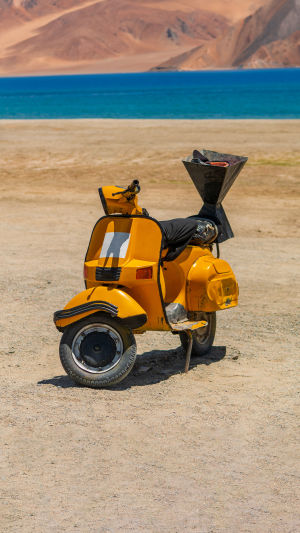A motorcycle, powered by a gasoline engine, is a two or three-wheeled vehicle controlled by handlebars for steering.
It's lightweight, agile, and capable of swift movement; it's widely employed for patrols and the transportation of goods and passengers, and it serves as sporting equipment.
Broadly speaking, motorcycles can be categorized as street bikes, road racing motorcycles, off-road motorcycles, cruisers, touring bikes, and more.
People often refer to the motorcycle engine as the gasoline engine. The main components of a motorcycle include the engine, transmission system, brakes, suspension, steering, electricals, and the frame.
Motorcycle engines are mostly two-stroke air-cooled gasoline engines, while some larger motorcycles use water-cooled four-stroke 4-6 cylinder engines. Light motorcycles generally have a gear transmission, while larger motorcycles can have 5-6 gear transmissions.
It's a single or double-seated rapid ground transportation powered by an internal combustion engine that is light, agile, and swift in motion. It has advantages such as being small, lightweight, high speed, good maneuverability, and ease of use.
In 1885, German inventor Gottlieb Daimler installed an engine onto a frame, giving birth to the world's first motorcycle. Motorcycle-related sports are a form of competitive sport involving motorcycles, categorized into two and three-wheeled types with different engine cylinder capacities. Competition formats include off-road races, multi-day races, road races, track races, and touring races, judged based on speed or driving skills.
Edward Butler of England attached a power device to a bicycle in 1884, creating a tricycle powered by kerosene. In 1885, German "father of the automobile" Gottlieb Daimler created a three-wheeled motorcycle powered by a single-cylinder, atmospheric gasoline engine.
On August 29 of the same year, he obtained a patent for this invention, thus being globally acknowledged as the inventor of the motorcycle. Daimler's first motorcycle used a four-stroke internal combustion engine with a working cylinder capacity of 264 cubic centimeters, producing 0.5 horsepower at 700 revolutions per minute and reaching a speed of 12 kilometers per hour. The vehicle had a wooden structure, with belt drive on the rear wheel and auxiliary support wheels on both sides.
Recognizing Daimler's invaluable historical contribution, the German Engineers Association erected a monument in his honor at Cannstatt Square after his passing because it was there he rode his first motorcycle.
In addition to German motorcycles, American motorcycles, notably the Harley-Davidson company, gained prominence. The first commercially sold model produced by Harley in 1903 had an engine cylinder capacity of 409 mL, generating 2.94 kW of power, utilizing a bicycle frame.
Motorcycles are products of their time, reflecting the technological levels of different eras. Primitive motorcycles couldn't be used because the technology of that time couldn't meet the basic components needed for their normal operation, confining them to experimental labs.
Motorcycles, having weathered a century of trials, are evolving toward modernity. The modern motorcycle industry has integrated numerous advanced technologies. For instance, Harley-Davidson introduced the FLHRC-1 model in 1998, incorporating top-notch automotive engine technology—the fuel injection system.
This is enhanced power and aligned with contemporary environmental needs, making it a trailblazer for 21st-century motorcycles.
Moreover, the utilization of high-tech features like optical communication electronic control systems, radar distance control systems, electronic map guidance systems, and electronic sound reduction systems in some conceptual motorcycles has made modern motorcycles more perfect and impressive.





